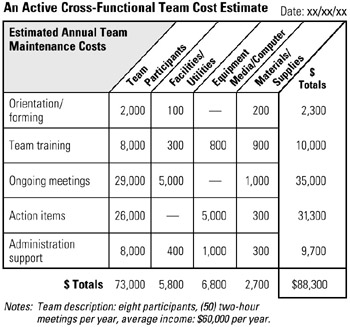Tool 163: Resource Requirements Matrix
| AKA | Requirements Matrix |
| Classification | Planning/Presenting (PP) |
Tool description
The resource requirements matrix reflects an estimated total cost for implementing an activity or major project. Required resource categories are identified and associated costs calculated. Costs are summed by resource categories and activities to provide a common understanding for planning and budgeting purposes.
Typical application
-
To plan and budget for implementation activities or process changes.
-
To estimate total project costs.
-
To provide supporting data for decision making.
Problem-solving phase
| Select and define problem or opportunity | |
| Identify and analyze causes or potential change | |
| → | Develop and plan possible solutions or change |
| → | Implement and evaluate solution or change |
| Measure and report solution or change results | |
| Recognize and reward team efforts |
Typically used by
| Research/statistics | |
| Creativity/innovation | |
| 2 | Engineering |
| 1 | Project management |
| 3 | Manufacturing |
| Marketing/sales | |
| 5 | Administration/documentation |
| 4 | Servicing/support |
| Customer/quality metrics | |
| Change management |
before
-
Information Needs Analysis
-
Consensus Decision Making
-
Case Study
-
Checklist
-
Dimensions Cube
after
-
Activity Cost Matrix
-
Cost-Benefit Analysis
-
Balance Sheet
-
Comparison Matrix
-
Matrix Data Analysis
Notes and key points
-
Identification of probable resource categories and required activities within these categories is part of the preliminary data collection.
-
Calculate averages of actual incomes, times, costs, etc., to increase degree of accuracy in calculated total resource costs.
Step-by-step procedure
-
STEP 1 A planning team systematically identifies required activities, personnel, facilities equipment, material, services, and other resources needed to implement or complete an activity or project.
-
STEP 2 The team recorder uses a whiteboard to draw a resource requirements matrix and inserts all identified data into the matrix. See example An Active Cross-Functional Team Cost Estimate.
-
STEP 3 Cost averages are calculated or estimated and recorded into the appropriate cells of the matrix, as shown in this example.
-
STEP 4 Finally, all rows and columns are summed, calculations are checked, and the matrix is dated.
Example of tool application

EAN: 2147483647
Pages: 326